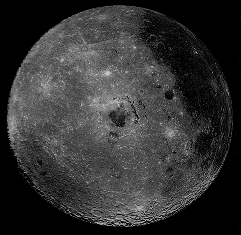
Note: Click on Solar System Exploration: Galileo Legacy Site (NASA-JPL) to get this image at its highest resolution.
This image of the western hemisphere of the Moon shows the Orientale Basin
(600 miles in diameter) in the center.
It was computer processed to enhance the visibility of small features.
December 9, 1990 at 9:35 a.m. PST. Range, 563,000 kilometers (350,000 miles).
Here's a view of the Moon that can't be seen from the Earth, showing parts
of both the "near" and "far" sides of the Moon!
(only one side of the Moon points towards the Earth).
This image was taken through a green filter.
The Orientale Basin was formed about 3.8 billion years ago by the impact of
an asteroid-sized body. Orientale's dark center is a small mare.
To the right is the near side of the Moon that faces the Earth, with the
great, dark Oceanus Procellarum above and the small, circular, dark Mare Humorum below.
Maria (from the Latin "mare," or "sea") are broad plains formed mostly over
3 billion years ago as vast basaltic lava flows.
To the left is the lunar far side (which is not visible from Earth) with fewer maria.
At the lower left is the South-Pole-Aitken basin, the largest, deepest
impact basin yet discovered in the Solar System. The basin is 2,500
kilometers (1,500 miles) in diameter, which resembles Orientale but is
larger, much older and more weathered and battered by cratering.
The intervening cratered highlands of both sides, as well as the maria, are
dotted with bright, young craters.
This image was "reprojected" so that the Orientale Basin is centered.
Next slide: Gaspra Rotation Sequence
Back to: Galileo To Jupiter
Link to: Solar System Exploration: Galileo Legacy Site (NASA - JPL)
Updated: August 18 '96
Best seen with MS Internet Explorer.
Back: ARVAL - Image Gallery
Messages: